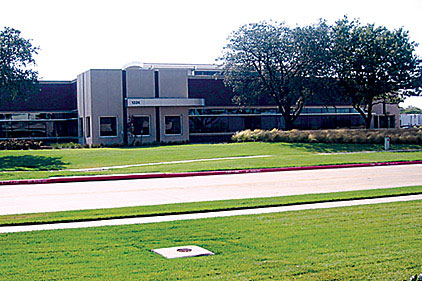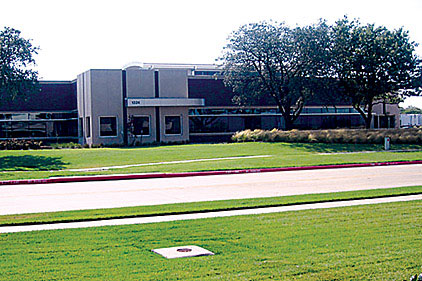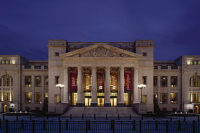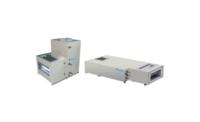 When Encore Wire, a manufacturer of copper electrical wire and cable was ready to expand, they knew they wanted sustainability to feature prominently in the design of their new building. They also knew those requirements would pose some challenges. The new Research and Development Center, located across from the company headquarters in McKinney, TX, was slated to house a one-floor research laboratory that would perform a variety of analytical functions, including analytical chemistry, wet chemistry, and destructive testing. The president of Encore Wire, who is a big proponent of sustainability, wanted the building to achieve LEED® Platinum status. Ultimately, the HVAC system would need to provide a significant amount of points towards successfully meeting that goal.
When Encore Wire, a manufacturer of copper electrical wire and cable was ready to expand, they knew they wanted sustainability to feature prominently in the design of their new building. They also knew those requirements would pose some challenges. The new Research and Development Center, located across from the company headquarters in McKinney, TX, was slated to house a one-floor research laboratory that would perform a variety of analytical functions, including analytical chemistry, wet chemistry, and destructive testing. The president of Encore Wire, who is a big proponent of sustainability, wanted the building to achieve LEED® Platinum status. Ultimately, the HVAC system would need to provide a significant amount of points towards successfully meeting that goal.
With special considerations like sustainability, space constraints, and redundancy, a custom HVAC solution was the best option. Ron Wyman, the engineer on the project, felt confident in his recommendation to use Temtrol, a CES Group® company.
“I rarely use a catalogued solution,” he said. “And I trusted the Temtrol unit. I have used so many Temtrol custom air handlers in the past, I knew I could trust them. I’ve always been pleased with Temtrol’s ability to provide a solution — and working with the Temtrol folks is always a pleasure.”
AT A UNIQUE APPLICATION
The analytical lab, one of only three of its kind in the country, presented a unique challenge. The lab houses sophisticated equipment and is used to expose the products Encore Wire manufactures to different testing procedures — from dipping the wires in 300-gal baths of boiling water to testing the insulation resistance, to flame chambers where the wires are rack-mounted and UL tested. The HVAC system needed to be able to heat, cool, and exhaust air from these testing chambers, and service the office space and shared areas like the lobby and lunchroom that were also housed in the building.
The entire 13,000-sq-ft building uses one 18,500 cfm Temtrol air handler, which produces about 1.4 cfm/sq ft. The labs themselves had to have 100% exhausted air, while offices and the general lab, lobby, and lunchroom use recirculated air. The building as a whole uses nearly 60% outside air, so the air handler needed to be able to respond to very low, or very high demands, depending on the weather. A condensing air cooled boiler, set to 130°, is used to provide heating water, which provides significant energy savings, as it is able to run in condensing mode at all times.
Wyman explains, “We had an owner’s performance requirement (OPR), then put the basis of design (BOD) together, which included all the requirements for each space — each office/lab required a different temperature range, which we accomplished using a VAV system.”
The building’s flame chamber room proved a particular challenge. An exhaust system was needed to collect all of the burnoff from the UL testing and ensure it didn’t get returned to the air handler. The flame chamber equipment required several thousand cfm of air. In addition, an abatement device is used to collect the effluent from the burn and to scrub the exhausted air. And the air handler needs to condition the space and make up for the exhausted air. Controls were installed that provided the ability to switch from “operational” flame test mode to “nonoperational” mode for use when testing wasn’t taking place, which allowed the space to remain negatively pressurized so it wouldn’t contaminate the rest of the building.
THE RIGHT FIT
Size was another critical concern, since the space was very tight. The air handler needed to fit within a penthouse on the top of the building, which presented serious space constraints — space constraints so tight, in fact, that two doors were needed to allow access for maintenance, one on either side of the penthouse.
The Fanwall system and an AHRI Certified™ enthalpy plate energy exchanger were installed in the AHU to pre-condition the outside air with air that is being exhausted out of the building. Because of its unique configuration, the Fanwall system produces a smaller footprint and takes up less space than a conventional AHU, saving 2.5 ft of space.
ENTHALPY PLATE ENERGY EXCHANGER
To maximize building energy efficiency, Encore utilized an enthalpy plate energy exchanger between the exhaust and outdoor airstreams. The airstreams do not touch and are separated by a membrane that transfers both heat and moisture between airstreams. In addition, this technology doesn’t include any moving parts, providing a significant advantage over some other options. The summer/ winter effectiveness ratings for the plate utilized were 73% / 80%, respectively.
LEED® PLATINUM
Space constraints and redundancy weren’t the only challenges. With a strong commitment to sustainability, Encore Wire wanted the new research facility, located across from the headquarters, to achieve LEED certification. Achieving LEED Platinum status required diligently looking for points wherever possible — and especially from an energy standpoint.
Says Wyman, “In trying to get to the Platinum level, we needed 20% energy savings. We worked hard to get the energies, like horsepower, down as low as we could to meet all the requirements.”
The building ultimately achieved 23% energy savings, earning Encore Wire four points for LEED Energy and Atmosphere - Credit 1. The use of F Fanwall Technology, which provided a lower electrical connection load and low fan horsepower, provided a significant advantage in terms of energy savings. Wyman also worked towards securing the IAQ/IEQ credit for indoor air pollution reduction, submitting an impressive 57 points. In addition, the building was able to achieve 88% in water savings, in part by collecting the condensate off the air handler, utilizing a grey water system that flushed into the commodes and a cistern that watered the lawn.
INTEGRATION PRODUCES RESULTS
Redundancy and energy efficiency were two of the most important characteristics in this demanding application. With the right team and the right products, the building was able to achieve the rare LEED Platinum certification. Integrating multiple technologies in the building created an exciting solution. The Encore Wire project is a testament to the power of creative thinking, hard work, and the benefits that advanced technologies can provide. The Temtrol air handler, combined with Fanwall Technology, played a critical role in the success of this project. ES






